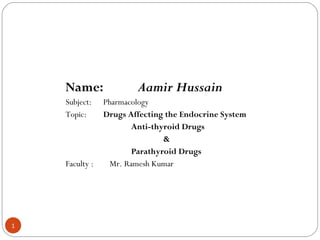
Drugs affecting the endocrine system presentation
- 1. Name: Aamir Hussain Subject: Pharmacology Topic: Drugs Affecting the Endocrine System Anti-thyroid Drugs & Parathyroid Drugs Faculty : Mr. Ramesh Kumar 1
- 2. Anti-thyroid drugs A number of drugs act as anti-thyroid drugs. Use for patients with hyperthyroidism. 2 Aamir Hussain
- 3. Anti-thyroid drugs Drugs used for the treatment of hyperthyroidism : Inhibition of hormone synthesis : Propylthiouracil and Methimazole. Blockade of hormone release : Iodides, Iodinated contrast media. Radioactive Iodine Anion Inhibitors : Perchlorates, Thiocynates. Beta blocking drugs : Propranolol. 3 Aamir Hussain
- 4. Anti-thyroid drugs THIOAMIDES : These are used for treatment of mild thyrotoxicosis and in preparation of surgery. Propylthiouracil is relatively safe and preferred in pregnancy. 4 Aamir Hussain
- 5. Anti-thyroid drugs THIOAMIDES : ADVERSE EFFECTS Common adverse effects includes maculopapular rash, arthralgia and vasculitis. Agranulocytosis – reversible. 5 Aamir Hussain
- 6. Anti-thyroid drugs ANION INHIBITORS : Monovalent ions like perchlorate, pertechnetate, thiocyanate can competitively block the uptake of iodine. Anion inhibitors are uncommon in use because of aplastic anemia. These are effective in iodine induced hyperthyroidism 6 Aamir Hussain
- 7. Anti-thyroid drugs Other Anti-thyroid drugs : Propranolol is used in the management of cardiac symptoms of thyrotoxicosis. Lithium is known to inhibit synthesis and release of thyroid hormones. Amiodarone can also result in hypothyroidism. 7 Aamir Hussain
- 8. Adverse Drug Reaction Fever Rash Headache Bloody diarrhea Depression Anorexia Gastric irritation 8 Aamir Hussain
- 9. Nursing Assessment Before drug therapy begins, review the patient’s history for conditions that contraindicate require cautious use of the prescribed anti-thyroid drugs. During treatment assess the patient for unfavorable drug reactions and signs of drug interactions. Also sometimes assess the effectiveness of therapy with the anti-thyroid drug. Finally, evaluate the patient’s and family’s knowledge about the prescribed drug 9 Aamir Hussain
- 10. Nursing Diagnosis Risk for injury related to a preexisting condition that contraindicate or requires cautious use of an anti-thyroid drug. Knowledge deficit related to the prescribed anti-thyroid drugs. Risk for injury related to adverse drug reactions or drug interaction. 10 Aamir Hussain
- 11. Planning and Implementation Do not administer an anti-thyroid drug to a patient with a condition that contraindicate its use. Administer an anti-thyroid drug carefully to a patient at risk because of a preexisting condition. Observe the patient for hypersensitivity reactions to the anti- thyroid drugs. Monitor the patient for signs of toxicity such as thyroid gland enlargement. 11 Aamir Hussain
- 12. Evolution For each nursing diagnosis, prepare an evaluation statement that describes the patient’s or family’s response to nursing intervention. 12 Aamir Hussain
- 13. Parathyroid Drugs The parathyroid drugs also referred to as a calcium regulators. Bone metabolism 13 Aamir Hussain
- 14. Parathyroid Drugs Alendronate Adverse gastrointestinal(GI)effects in dose more then 10mg. Decrease alendronate absorption 14 Aamir Hussain
- 15. Parathyroid Drugs Calcitonin Increase bone resorption, intestinal absorption, and kidney reaborption of calcium. Etidronate disodium Decreased absorption of etidronate disodium. Calcifediol Decrease calcifedional absorption 15 Aamir Hussain
- 16. Adverse Drug Reaction Hypocalcaemia Flushing Nausea Vomiting Swelling tenderness of the hands Diarrhea Headache 16 Aamir Hussain
- 17. Nursing Assessment Before drug therapy begins, review the patient’s history for condition that contraindicate or require cautious use of the prescribed parathyroid drugs. Review the patient’s history to identify use of drugs that may interact with it. During drug therapy, assess the patient for adverse drug reactions and signs of during interaction. 17 Aamir Hussain
- 18. Nursing Diagnosis Risk for injury related to a preexisting condition that contraindicates or requiires cautious use of a parathyroid drug. Risk for injury related to adverse drug reactions or drug interactions. Knowledge deficit related to the prescribed parathyroid drug. 18 Aamir Hussain
- 19. Planning and Implementation Do not administer a parathyroid drug to a patient with a condition that contraindicates its use. Monitor the patient for adverse reaction and drug inter- actions during treatment with a parathyroid drug. Protect calcitriol and dihydrotachysterol from heat and light to prevent loss of potency. Do not refrigerate dihydrotachysterol. Notify the physician if unfavorable reactions or drug inter-actions occur. 19 Aamir Hussain
- 20. Evolution For each nursing diagnosis, prepare an evolution statement that describes the patients' or family’s response to nursing intervention. 20 Aamir Hussain
- 21. Thanks 21 Aamir Hussain
Notas del editor
- Slow in onset ~ 4 weeks because they do not inhibit secretion of hormones. These may exert immunosuppressive effects. Acts by inhibiting peroxidase and thus block coupling reaction and iodine organification.
